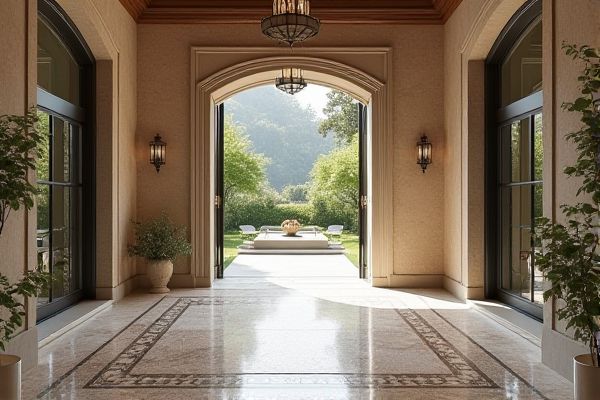
Terrazzo tiles offer a colorful, customizable surface with a smooth, polished finish that resists stains and scratches, making them ideal for terraces seeking a modern aesthetic. Granite tiles provide superior durability and natural stone elegance with excellent weather resistance, perfect for outdoor spaces exposed to harsh conditions; explore the rest of the article to find which option best suits your terrace needs.
Table of Comparison
| Feature | Terrazzo Tiles | Granite Tiles |
|---|---|---|
| Material Composition | Composite of marble, quartz, granite chips in cement or resin | Natural igneous rock formed from cooled magma |
| Durability | High, resistant to cracking and chipping | Very high, extremely hard and long-lasting |
| Maintenance | Low, requires occasional sealing | Moderate, needs regular sealing to prevent stains |
| Slip Resistance | Good, can be enhanced with surface treatment | Moderate, depends on finish (polished or textured) |
| Cost | Generally more affordable | Typically more expensive |
| Aesthetic | Variety of colors and patterns, customizable | Natural stone patterns, limited to natural color range |
| Ideal Use | Outdoor terraces, patios with moderate foot traffic | Outdoor terraces requiring high durability and luxury look |
Introduction to Terrace Tile Options
Terrazzo tiles offer a versatile and customizable surface composed of marble, quartz, granite, or glass chips embedded in cement or epoxy, providing durability and artistic design for terraces. Granite tiles are natural stone options known for their robustness, weather resistance, and elegant appearance, ideal for outdoor terrace flooring with minimal maintenance. Both materials excel in hardness and weather resilience, but terrazzo allows greater design flexibility, while granite emphasizes natural stone aesthetics and longevity.
What Are Terrazzo Tiles?
Terrazzo tiles are composite flooring materials made from a mixture of marble, quartz, granite, or glass chips embedded in a cement or epoxy resin binder, polished to achieve a smooth, durable surface. Known for their versatility, terrazzo tiles offer customizable patterns, vibrant colors, and excellent resistance to stains and wear, making them ideal for terrace applications. Their unique blend of aesthetics and durability distinguishes terrazzo from natural stone options like granite tiles, which consist of solid slabs of igneous rock offering higher hardness but less design flexibility.
What Are Granite Tiles?
Granite tiles are natural stone tiles cut from granite, an igneous rock known for its durability, hardness, and resistance to weathering, making them ideal for terrace flooring. These tiles feature unique mineral patterns and colors, providing a luxurious and timeless aesthetic for outdoor spaces. Their dense composition ensures high resistance to scratches, stains, and moisture, enhancing longevity in terrace applications compared to other materials like terrazzo tiles.
Aesthetic Differences: Terrazzo vs Granite Tiles
Terrazzo tiles offer a vibrant, speckled appearance with customizable chips of marble, glass, or quartz embedded in concrete, creating unique patterns ideal for artistic terrace designs. Granite tiles showcase natural stone aesthetics with distinctive grain and color variations, providing a timeless, elegant look that enhances the terrace's sophistication. Your choice depends on whether you prefer the creative versatility of terrazzo or the classic, durable beauty of granite for your outdoor space.
Durability and Weather Resistance
Terrazzo tiles offer excellent durability due to their composite nature, combining marble, quartz, or glass chips with a cement or epoxy binder, making them resistant to cracks and stains. Granite tiles provide superior weather resistance, with natural hardness and low porosity that withstand harsh outdoor conditions like freeze-thaw cycles and UV exposure on terraces. Both materials are suitable for terraces, but granite excels in long-term exposure to extreme weather, while terrazzo requires sealing for optimal protection.
Installation Process Comparison
Terrazzo tiles require a precise and time-intensive installation involving a cement or epoxy base that must be poured, cured, and polished, which demands skilled labor and longer project timelines. Granite tiles are generally easier and quicker to install due to their durability and ability to be directly adhered to the terrace surface with mortar or adhesive, reducing labor costs and downtime. When choosing your terrace flooring, consider that terrazzo installations offer highly customizable aesthetics, whereas granite provides robust, low-maintenance surfaces with faster installation.
Maintenance Requirements
Terrazzo tiles require regular sealing and occasional polishing to maintain their smooth, glossy finish and prevent staining, while granite tiles need periodic sealing to protect against moisture and keep their natural stone luster intact. Both materials benefit from routine cleaning with pH-neutral cleaners, but terrazzo is more prone to surface scratches compared to the harder granite. Proper maintenance of each tile type ensures enhanced durability and aesthetic appeal for terrace installations.
Cost Analysis: Terrazzo vs Granite
Terrazzo tiles offer a more cost-effective solution for terrace flooring, with prices typically ranging from $20 to $50 per square foot, whereas granite tiles can cost between $40 and $100 per square foot due to their natural stone composition and durability. Installation costs for terrazzo are generally lower, benefiting from easier customization and quicker setting times compared to the labor-intensive cutting and fitting required for granite. Your choice will impact long-term maintenance expenses, as terrazzo is more stain-resistant and requires less sealing than granite, influencing overall cost efficiency.
Eco-Friendliness and Sustainability
Terrazzo tiles are highly eco-friendly, incorporating recycled materials such as glass, marble chips, and cement, which reduces waste and lowers resource consumption compared to granite tiles. Granite tiles involve quarrying processes that result in significant environmental disruption and higher carbon emissions due to extraction and transportation. Choosing terrazzo supports sustainability goals by promoting recycled content use and reducing the ecological footprint of terrace flooring.
Best Choice for Your Terrace: Final Verdict
Terrazzo tiles offer unparalleled design versatility and superior resistance to stains and wear, making them an excellent choice for terraces that demand both aesthetics and durability. Granite tiles provide exceptional hardness and natural stone appeal, ideal for terraces exposed to heavy foot traffic and harsh weather conditions. Your final decision should balance terrazzo's creative flexibility with granite's strength to ensure a long-lasting, visually appealing terrace surface.
 homyna.com
homyna.com